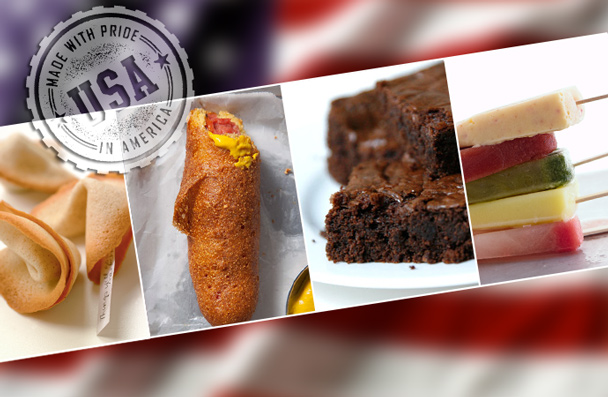The United States may be synonymous with apple pie and Cracker Jack, but rest assured Uncle Sam gets the credit for other specialties as well. For July 4th, we've rounded up an eclectic list of dishes invented in America. Dig into this assortment, more humble than haute, and savor the stories.
Corn Dogs
Corn dogs' emergence in culinary Americana likely dates back to the 1920s and the invention of the Krusty Korn Dog pan, in which corn-battered sausages were baked to resemble ears of corn. The deep-fried variety didn't emerge until around 1940, when state fairs in Texas and Minnesota began selling the snack on a stick for easy eating. By 1946, corn dogs had gone mainstream with the opening of the first Hot Dog on a Stick restaurant (originally called Party Puffs) in Muscle Beach, California. The chain has since expanded to more than 100 locations in a dozen states, all the while maintaining its founding mission to "stick a smile on your face!"
Brownies
Far from fudge and denser than most cakes, bar-shaped brownies began to appear in the late 19th and early 20th centuries. There's debate over the dessert's exact date and place of origin, but many food historians, as well as the famed French food encyclopedia Larousse Gastronomique, cite the 1896 edition of The Boston Cooking-School Cook Book by Fannie Merritt Farmer as the oldest reference. Farmer's seminal cookbook included a recipe for a dessert made with browned molasses, but no chocolate, resembling more of a cookie than a brownie. Farmer's 1906 revised edition featured a more characteristic brownie recipe. Made with flour, eggs, chocolate, and butter, it earned the name "brownie" for its rich brown color.
Fortune Cookies
Although associated with Chinese cuisine, fortune cookies are actually as American as apple pie. Food historians point to a number of possible pedigrees for this crunchy confection, but most agree that the first-ever fortune cookies were created in California in the early 20th century. The cookies, famous for the paper fortunes tucked inside their folds, were originally crafted by hand, using chopsticks. It wasn't until the 1960s that producers made the switch to machines, according to The Encyclopedia of American Food & Drink by John F. Mariani. Chinese proverbs, suggested lottery numbers, jokes, biblical references, and quotes from pop culture are among the inspirations for the sayings inside.French Dip Sandwich
Philippe Mathieu, a transplant from France to Los Angeles, is credited with inventing the famous French Dip sandwich: layers of warm, thinly sliced roast beef stacked on a French roll and bathed in the meat's natural juices. As legend has it, one day in 1918, Mathieu was preparing a sandwich in Philippe's, his Southern California restaurant, when he inadvertently dropped a French baguette into a nearby roasting pan filled with beef juices. His customer said he'd take the sandwich anyway, au jus and all, and the French Dip sandwich was born. Although Mathieu is undoubtedly associated with inventing the deli classic, some question whether he may have intentionally doused the baguette, or if it truly did take a fortuitous fall.Graham Crackers
Long before there was Atkins, South Beach, and Dukan, there was the Graham diet, a nutritional approach advocated by Sylvester Graham, a Presbyterian minister and dietary reformer in Bound Brook, New Jersey. This diet consisted mainly of fruits and vegetables, as well as a strict regimen of high fiber and whole wheat foods, which led Graham to invent his namesake cracker in 1829. The original recipe was for unsweetened biscuits made with coarsely ground unbleached whole wheat flour with wheat bran and germ (now known as graham flour). Over the years, the crackers turned from savory to sweet with the addition of sugar or honey, and became a standard component of another classic American creation: the s'more.
Green Goddess Dressing
Green Goddess dressing—a creamy blend of mayonnaise, anchovies, garlic, vinegar, scallions, and fresh herbs—could have been named for its characteristic hue but was in fact a tribute to British actor George Arliss, star of the famous 1920s play The Green Goddess. Philip Roemer, then executive chef of San Francisco's Palace Hotel, wanted to honor the stage and screen legend, who was staying at the hotel (and would later become the first British actor to win an Academy Award, for his role in the 1929 film Disraeli). The dressing quickly became a popular menu item in restaurants nationwide and is also now commonly served as a dip alongside crudités.



 Pinterest
Pinterest


